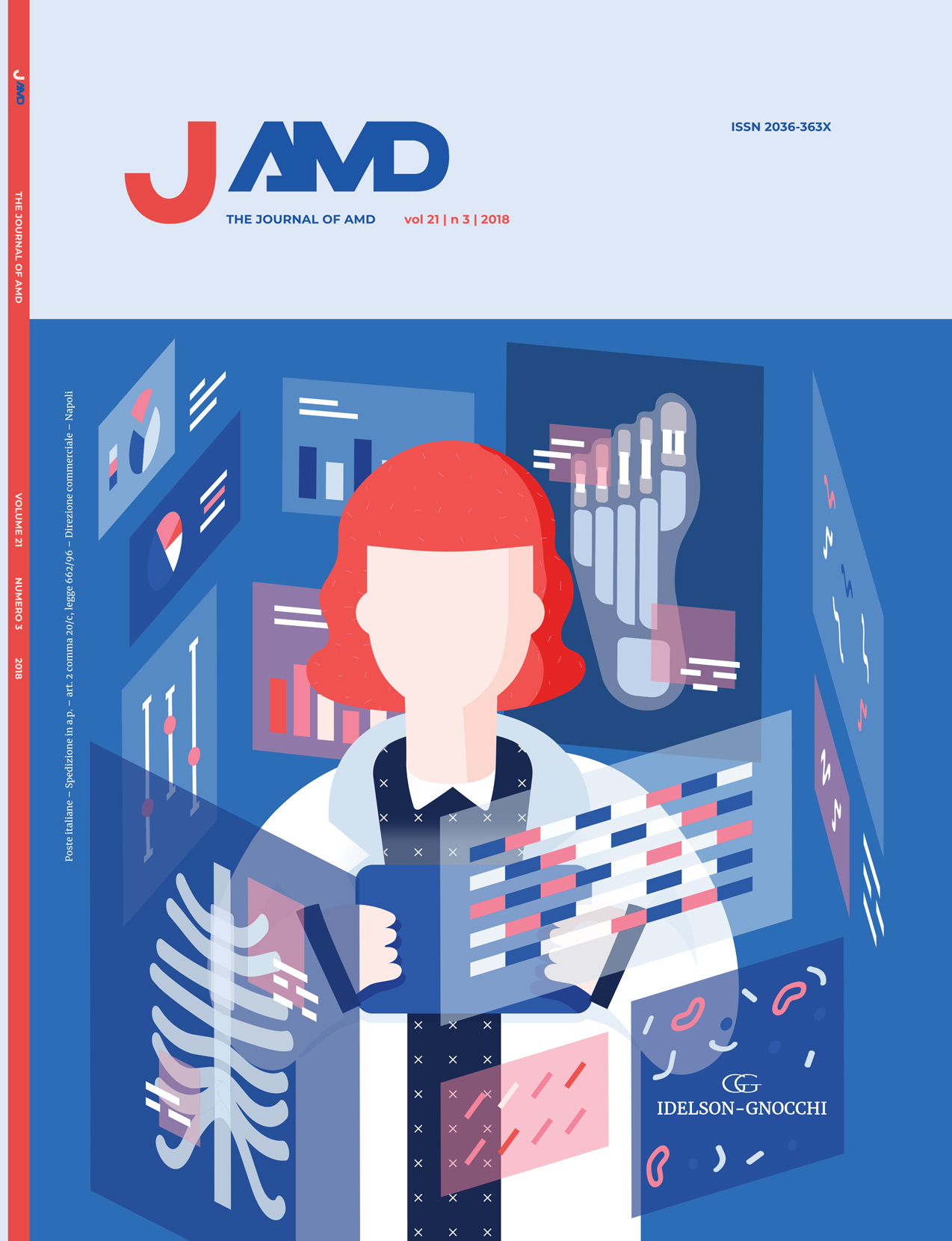Editorial
Do Androids Dream of Electric Sheep?
JAMD 2018;21(3):177-178
Original articles
Diagnostic and therapeutic work-up as part and parcel of exercise related personalized care in people with diabetes
JAMD 2018;21(3):179-196
Data concerning significant preventative and therapeutic effects are so convincingly sound that nowadays diabetes specialists are used to suggest their patients to become physically active, without going too in depth into the topic though. In fact, when dealing with safe long-lasting exercise sessions rather than mere physical activity, doctors have to know how to prevent acute complications and, to do so, have to take into account type, duration, intensity, timing and level of training. At the moment international guidelines still suggest to personalize treatment according to a prudent “trial and error” method. However, due to the benefits of exercise in terms of metabolic control, overall management of chronic micro- and macrovascular complications as well as quality of life, we felt it necessary to try and take advantage of most recent research progresses in the field together with our own personal long-lasting experience with diabetic athletes to prepare this document concerning the diagnostic and therapeutic work-up as part and parcel of exercise related personalized care in people with diabetes. We hope it will be used as a handy toolbox for both diabetes specialists prescribing exercise and people with diabetes willing to get more and more active all the time.
KEYWORDS diagnostic-therapeutic work-up; exercise; insulin; method; motivation.
Case series
L-PRF (fibrinrich in leukocytes and platelets): use in three cases of diabetic Ulcer with chronic Osteomyelitis
JAMD 2018;21(3):197-203
The hypothesis is that the use of fibrin rich in leukocytes and platelets (L-PRF) in osteomyelitis from ulcer on diabetic foot, allows recovery from this serious disease. In this study, the goal was to standardize the use of L-PRF in patients with osteomyelitis to direct it to healing.
The authors produced and used peripheral blood L-PRF membranes in 3 patients (all diabetics) with osteomyelitis with skin lesions for at least 6 months. The membranes, together with the supernatant liquid after compression, were inserted into the skin lesion up to the bone after surgical debridement. The evolution of lesions over time has been analyzed.
All three patients had positive Probe-to-Bone test, MRI detected cortico-periosteal thickening and / or focal points of cortico-spongiosa osteolysis in adjacency of the ulcer. Gram-positive bacteria were found in our patients in 52% of cases. Cocci Gram +, as S. Aureus (15.6%), S. β-haemolytic (12.1%), S. Viridans (7.1%) and Bacilli Gram- as Pseudomonas (10.6%), Proteus (7.8%), Enterobacter (5.7%) are present. Candida is present in 2.8%.
The blood count showed no major changes.
To date, all three patients have healed cutaneous lesions (a two year old patient) with no signs of infection, or recurrence.
The use of L-PRF in diabetic foot osteomyelitis will improve our understanding of wound healing, particularly in regenerative therapy of chronic skin lesions. The results obtained on our patients suggest that L-PRF membranes may be a therapeutic option in this difficult treatment pathology.
Reviews
Artificial Intelligence and Big Data in Medicine: scenarios, opportunities and critical issues
JAMD 2018;21(3):204-218
In the last two years digital information around the world has more than doubled and this trend is going to increase exponentially by generating huge amounts of digital data: the Big Data. Medicine is a key player of this growth because of four important phenomena: the digitization of diagnostic imaging, digital reporting replacing of paper folders, the development of the biotechnology in the field of so-called “omics” sciences and the explosion of the IoMT (Internet of Medical Things). Through the techniques of Machine learning, computers are able to learn from the data without being explicitly programmed for this, creating predictive models. Artificial intelligence includes information systems that can perform tasks normally requiring human intelligence, such as visual perception, language recognition, decision making, translating from one language to another. It was born a cultural, technological and scientific phenomenon centered on the application of machine learning to very large databases. Artificial intelligence, computer vision and machine learning systems are proving that today the machines analyze large amounts of data faster and better than human beings. The new paradigm of a science that “simulate the human reasoning” instilled doubts whether this phenomenon is under human control. This review provides a summary and a glossary on the artificial intelligence technologies in medicine and on the main issues that their use can generate, in the view that machine learning is not a wand that can turn data into gold, but an invaluable tool, more and more necessary for medicine and modern health care system, whose complexity today exceeds the human mind ability. The human intelligence combined with the artificial intelligence – i.e. a knowledgeable and empathic clinician, empowered by reliable predictive tools and clinical decision support systems and unburdened by repetitive work – can bring us closer to the true “patient centered care.”
KEYWORDS artificial intelligence; big data analytics; clinical decision making; human behaviour; healthcare
Position Statement
Artificial Intelligence and Big Data in the field of Diabetes. The AMD vision
JAMD 2018;21(3):219-231
Since quite time most of our daily activities have turned out to be digital. This change is affecting our work as diabetologists. Digital health takes into account the ever increasing synergy between advanced medical technologies, innovation and digital communication. Thanks to Machine Learning we may obtain greater value from data as it allows not only to carry out a descriptive assessment (past reports analysis) but also to identify patterns and suggest predictions resulting from inductive reasoning that pertain to the human mind. In the diabetes field these analysis tools may help to define new risk factors both relating to the causes of diabetes and to its complications and, therefore, they may guide therapeutic choices. A further improvement in the data analysis is the prescriptive analysis: Machine Learning software that disclose the reasoning behind a prediction allow for “what-if” models by which it is possible to understand if and how, by changing certain factors, one may improve the outcome, thereby, identifying the optimal behavior.
Today diabetes care is facing with several challenges: the decreasing number of diabetologists, the increasing number of patients, the reduced allowed time for medical visits, the growing complexity of the disease, both from the clinical and the patient- care standpoint, the difficulty of achieving the relevant clinical targets, the growing burden of disease management for both the healthcare provider and the patient, the healthcare accessibility and sustainability. In this context, the new digital technologies and the use of the artificial intelligence, certainly are a great opportunity. This paper is the result of a careful analysis of the current literature and represents AMD’s vision on this controversial topic that, if well used, may be the key for a great scientific innovation. AMD believes that the use of artificial intelligence will allow to turn data (descriptive) into knowledge of the factors that “affect” the behavior and correlations (predictive), thereby identifying the key aspects that may establish an improvement of the expected results (prescriptive). Artificial Intelligence can therefore become a tool of great technical support to help diabetologists, who still are the “irreplaceable minds”, to become fully responsible of the individual patient, assuring customized and precise medicine. This, in turn, will allow for comprehensive therapies built in accordance with the evidence criteria that should always ground any therapeutic choice.
KEYWORDS artificial intelligence, big data analytics, clinical decision making, diabetes management, healthcare




